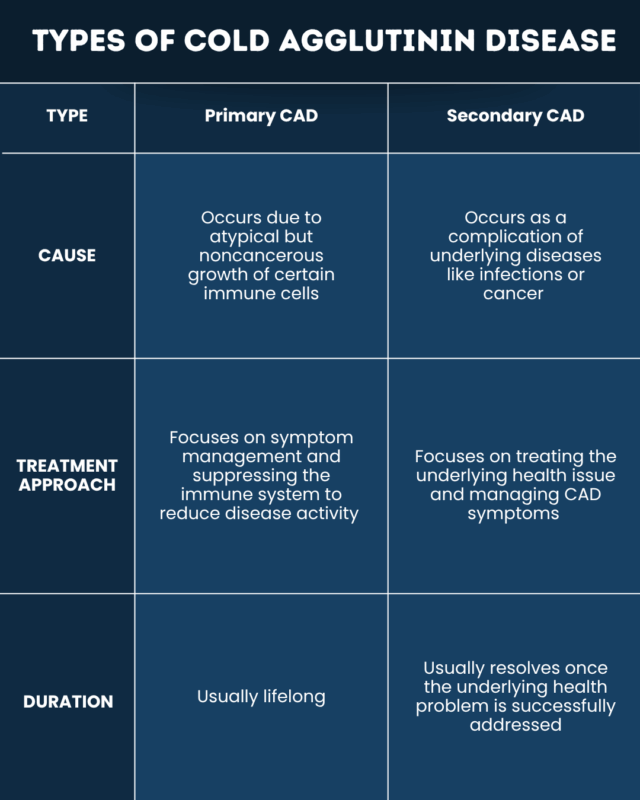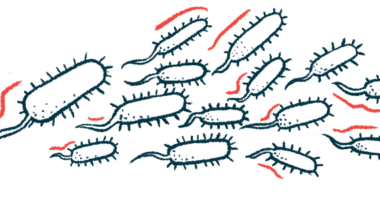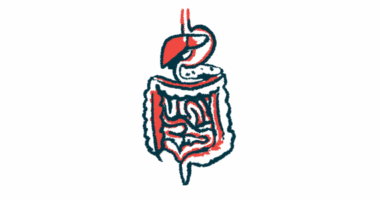Types of cold agglutinin disease
Last updated Sept. 29, 2025, by Marisa Wexler, MS

Cold agglutinin disease (CAD) is a rare autoimmune disorder caused by self-reactive antibodies called cold agglutinins that attack red blood cells at low temperatures. This causes cold agglutinin-induced hemolytic anemia, where red blood cells are destroyed faster than they are produced, and circulatory problems give rise to CAD symptoms.
There are two types of cold agglutinin disease, primary and secondary, that differ based on whether they are associated with an underlying health condition or not. Distinguishing between primary and secondary CAD is key to making optimal treatment decisions, as therapeutic approaches generally differ.
Primary cold agglutinin disease
Primary CAD, sometimes simply called CAD, develops without any other underlying health problems. It is thought to be caused by an atypical but noncancerous growth of B-cells, the immune cells responsible for making antibodies.
In primary CAD, this type of abnormal B-cell growth, known as a clonal lymphoproliferative B-cell disorder, is believed to involve cold agglutinin-producing B-cells, thereby increasing the levels of these antibodies that ultimately trigger CAD symptoms.
Excessive B-cell growth in primary CAD occurs in the bone marrow, where new blood cells are made. Exactly why these B-cells start to grow more than usual is not well understood, but several genetic abnormalities have been associated with primary CAD. While this atypical B-cell growth can progress to become cancer, this is quite rare, estimated to occur in less than 4% of CAD patients.
Primary CAD can affect anyone, but it most commonly affects elderly or middle-aged people. The condition is nearly twice as common in women as in men.
Primary CAD is typically a chronic or long-term condition; most people with CAD will have it for the rest of their lives. Still, symptoms of chronic CAD can vary considerably over time. Triggers such as cold temperatures, fever-inducing infections, or major surgery can lead to acute flares, or periods of sudden symptom worsening.
Secondary cold agglutinin disease
Secondary CAD, also known as cold agglutinin syndrome or CAS, develops as a complication of a different, underlying health problem. Causes of secondary CAD include:
- viral infections, including those caused by the Epstein-Barr virus, hepatitis B virus, hepatitis C virus, cytomegalovirus, adenovirus, influenza A virus, and SARS-CoV-2 virus (which causes COVID-19)
- bacterial infections, including those caused by Mycoplasma pneumoniae, Legionella pneumophilica, and Chlamydia pneumonia
- blood cancers, including lymphoplasmacytic lymphoma, marginal zone lymphoma, non-Hodgkin lymphoma, and Waldenström macroglobulinemia
- autoimmune diseases such as lupus and rheumatoid arthritis
While the mechanisms behind this type of CAD remain largely unclear, abnormal immune responses, cancerous growth of a single cold agglutinin-producing B-cell, and similarities between molecules on certain microbes and red blood cells are believed to play a role.
Secondary CAD related to infections is usually acute, often resolving within a matter of weeks. By contrast, secondary CAD related to cancer or autoimmune disease is more likely to be chronic and long-lasting, at least as long as the underlying disease is present. Therefore, a key difference between primary and secondary CAD is that the latter usually disappears once the underlying health condition is treated.

How doctors differentiate the types
When someone is suspected of having CAD, clinicians usually perform tests to diagnose the condition and its type. This typically involves looking for underlying conditions that can cause secondary CAD and/or the abnormal B-cell growth that characterizes primary CAD.
Testing to differentiate CAD types may include:
- blood tests to look for bacterial and viral infections
- imaging tests to look for signs of cancer
- bone marrow biopsy to look for atypical B-cell growth
Identifying the type of CAD is extremely important, as treatment strategies differ considerably between the two types.
Treatment outlook by type
Management of primary CAD usually involves lifestyle adjustments to avoid triggers, most notably taking steps to stay warm wherever possible. In cases of mild anemia and absent or tolerable symptoms, this may be all that’s needed to keep the disease under control.
Treatments used for primary CAD include:
- Enjaymo (sutimlimab-jome), a CAD-approved medication that blocks activation of the immune complement cascade, which contributes to CAD-related red blood cell destruction
- therapies that kill B-cells, such as rituximab (sold as Rituxan and others, with generics available), which can help reduce levels of disease-driving cold agglutinins
- blood transfusion to replenish lost red blood cells
In contrast, management of secondary CAD usually involves supportive care to manage CAD symptoms and medications focused on addressing the underlying health problem. Such medications may include:
- antibiotic or antiviral therapies to manage infections
- treatments for cancer, such as chemotherapy
- immunosuppressive therapies to manage autoimmune diseases
Cold Agglutinin Disease News is strictly a news and information website about the disease. It does not provide medical advice, diagnosis, or treatment. This content is not intended to be a substitute for professional medical advice, diagnosis, or treatment. Always seek the advice of your physician or other qualified health provider with any questions you may have regarding a medical condition. Never disregard professional medical advice or delay in seeking it because of something you have read on this website.
Recent Posts
- After months of fatigue, feeling better is what I want for Christmas
- Man’s case shows bacterial lung infection can ‘provoke’ clots, CAD
- Living with cold agglutinin disease involves cruel curveballs
- Gastric lymphoma found to be hidden cause of refractory CAD
- New CAD treatments, like reading progress, prove growth is possible
- ANX1502 proof-of-concept trial to wrap up next year, Annexon says
- What if Sadie Hawkins Day made me the doctor?
- Iptacopan rapidly stops red blood cell damage in rare CAD case
- Auburn isn’t sticking to the plan, but I am as I battle CAD fatigue
- Adapting and finding balance in caregiver-patient relationships
Related articles
-
December 10, 2025 by Mary Lott
After months of fatigue, feeling better is what I want for Christmas
-
December 3, 2025 by Mary Lott
Living with cold agglutinin disease involves cruel curveballs
-
November 19, 2025 by Mary Lott
New CAD treatments, like reading progress, prove growth is possible




